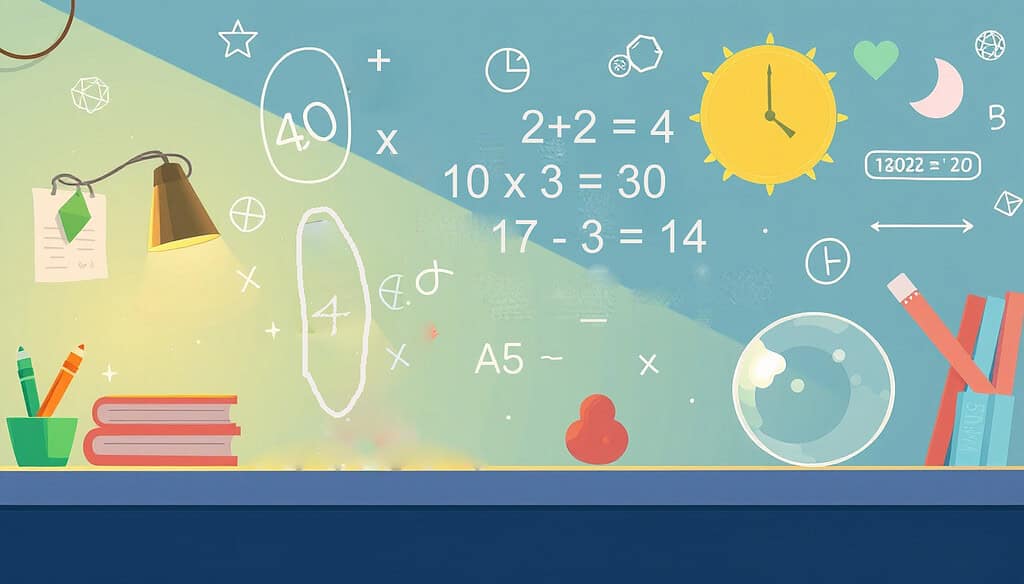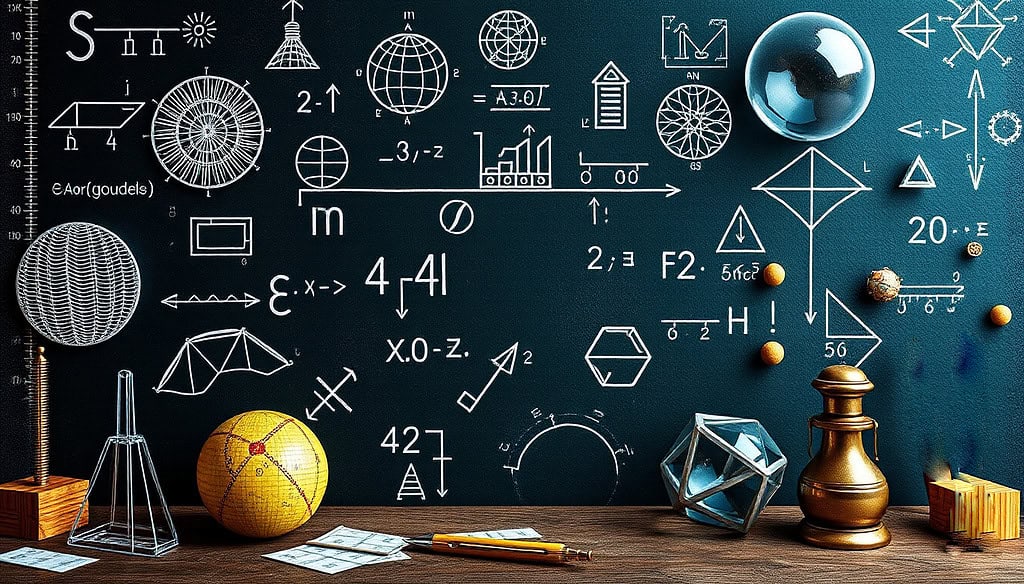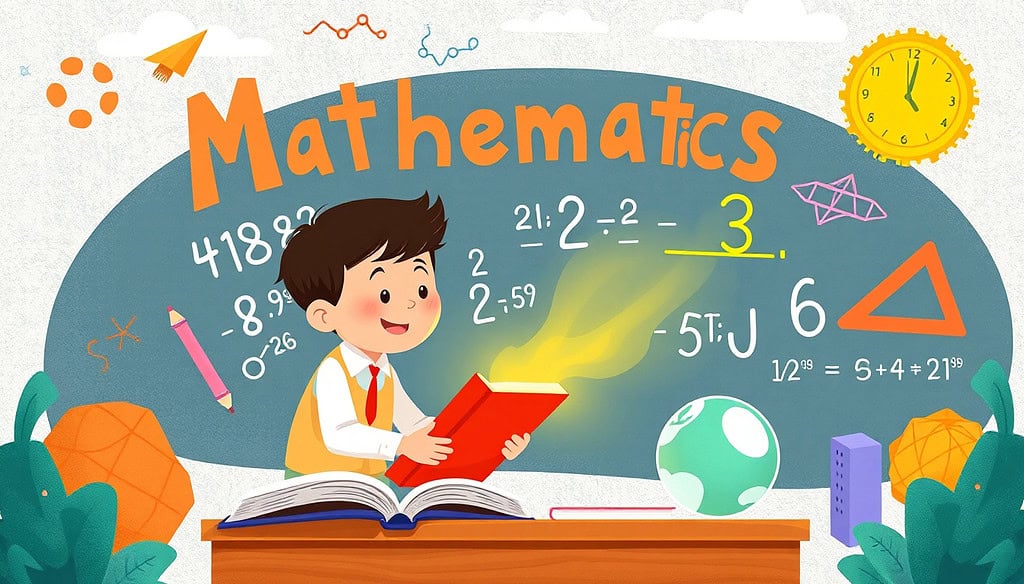Table of Contents
What is Mathematics and Why It is Important

Mathematics is one of the STEM (Science, Technology, Engineering, and Mathematics) subjects. It is a vast and intricate field of study that explores numbers, quantities, shapes, and patterns. It serves as a foundation for numerous disciplines, including science, engineering, economics, and social sciences. At its core, mathematics is about understanding relationships and structures, allowing us to analyze and interpret the world around us. From simple arithmetic to advanced calculus and beyond, mathematics encompasses a variety of concepts and techniques that are essential for solving complex problems.
The importance of mathematics cannot be overstated. It is a critical tool for logical reasoning and critical thinking. By engaging with mathematical concepts, individuals learn to approach problems systematically, breaking them down into smaller, manageable parts. This methodical thinking extends beyond mathematics and can be applied to various real-life situations, fostering a problem-solving mindset.
Moreover, mathematics plays a vital role in technological advancement. The digital age relies heavily on algorithms, data analysis, and computational models, all of which stem from mathematical principles. Fields such as computer science, artificial intelligence, and cryptography depend on mathematics to develop innovative solutions and technologies. In this way, mathematics acts as a driving force behind progress and development in modern society.
Another significant aspect of mathematics is its universality. Mathematical concepts transcend cultural and linguistic barriers, making it a global language. Whether in engineering, finance, or the natural sciences, mathematics provides a common framework that professionals from diverse backgrounds can utilize. This universality fosters collaboration and understanding among individuals worldwide, facilitating the exchange of ideas and advancements.
Furthermore, mathematics encourages precision and clarity in communication. Formulating mathematical expressions and equations requires careful consideration of language and notation. This precision extends to written and verbal communication, where conveying ideas effectively is crucial. The skills developed through studying mathematics—such as attention to detail and logical reasoning—are invaluable in both personal and professional contexts.
In the field of education, mathematics is frequently regarded as a fundamental subject. Mastery of mathematical concepts is essential for success in higher education and various career paths. Students who struggle with mathematics may find themselves at a disadvantage in a world that increasingly values quantitative literacy. Thus, ensuring that individuals are proficient in mathematics is critical for fostering a well-rounded, educated populace.
In conclusion, mathematics is more than just a subject; it is a vital discipline that underpins various aspects of life and society. Its role in fostering critical thinking, driving technological innovation, and promoting clear communication makes it an essential area of study. As we navigate an increasingly complex world, understanding the significance of mathematics is more important than ever.
Why You Should Be Efficient A Mathematics

Being proficient in mathematics is not merely an academic requirement; it is a vital skill that can significantly impact your personal and professional life. In today’s fast-paced world, where data-driven decision-making is paramount, the ability to think mathematically enhances your problem-solving capabilities and equips you with tools to analyze complex situations.
First and foremost, efficiency in mathematics improves your analytical skills. It encourages a systematic approach to problems, enabling you to break down complex issues into simpler components. This analytical mindset is crucial in various fields, from business to healthcare, where making informed decisions is critical. The capacity to interpret data and draw conclusions is a valuable asset in today’s information-driven society.
Moreover, proficiency in mathematics enhances your employability. Many careers require a solid understanding of mathematical principles, especially in sectors such as finance, engineering, technology, and science. Employers often seek candidates with strong quantitative skills, as these abilities are linked to critical thinking and problem-solving. Therefore, being efficient at mathematics can open doors to a wide range of career opportunities and provide a competitive edge in the job market.
In addition, mathematics fosters creativity and innovation. While often perceived as rigid and structured, mathematics encourages creative thinking by challenging individuals to explore various problem-solving strategies. Engaging with mathematical concepts can inspire innovative solutions to real-world challenges. This creativity is particularly relevant in fields like engineering and computer science, where novel ideas are crucial for technological advancement.
Furthermore, being efficient at mathematics enhances everyday life skills. From budgeting and financial planning to understanding statistics and making informed decisions, mathematical skills play a significant role in daily activities. A solid foundation in mathematics empowers individuals to manage their finances effectively, understand loans and interest rates, and make sound investments. These skills contribute to long-term financial stability and success.
Mathematics also cultivates persistence and resilience. Solving mathematical problems often requires patience and the willingness to tackle challenges repeatedly. This perseverance can translate into other areas of life, encouraging a growth mindset and the ability to face obstacles head-on. Learning to overcome difficulties in mathematics can foster a sense of accomplishment and build confidence.
Lastly, in an era dominated by technology and data, being efficient in math equips you to engage with the digital landscape critically. Data literacy is becoming increasingly essential as we navigate an ocean of information. Understanding statistical principles and being able to analyze data are crucial for making sense of the vast amounts of information available today. This understanding allows individuals to discern credible information from misinformation and make informed decisions.
In summary, being proficient in mathematics is essential for personal growth, professional success, and everyday life. The analytical skills, creativity, and resilience developed through mathematical study are invaluable in various contexts. As the world continues to evolve and embrace new technologies, the ability to think mathematically will remain a critical skill for navigating the complexities of modern life.
8 Interesting Ways to Become Efficient At Mathematics

1. Gamification of Learning
Gamification of learning transforms the often rigid and abstract world of mathematics into an engaging and dynamic experience. By incorporating game elements into math education, students can enjoy challenges that enhance their problem-solving abilities while having fun. This approach can be found in various formats, such as math-related apps, online platforms, and board games designed specifically for learning. These resources often present mathematical problems in a competitive format, allowing learners to earn points, unlock levels, or compete with peers.
One significant benefit of gamifying math is its ability to motivate students. Traditional learning methods can sometimes lead to boredom or frustration, especially when students encounter challenging topics. Gamification introduces an element of excitement and achievement, encouraging students to engage with content they might otherwise avoid. For example, many educational apps provide immediate feedback, helping students recognize their strengths and areas that require improvement in real time. This instant reinforcement can boost confidence and make the learning process more enjoyable.
Moreover, gamification fosters a growth mindset. When students play math games, they learn to approach challenges with resilience. They become accustomed to trial and error, realizing that making mistakes is a natural part of the learning process. This perspective encourages a willingness to tackle complex problems without fear of failure, which is crucial for developing mathematical proficiency.
Additionally, gamification can be tailored to different learning styles and preferences. Whether a student is visual, auditory, or kinesthetic, there are gamified math experiences that can cater to their needs. This adaptability ensures that all learners can find ways to engage with mathematics that resonate with them.
In conclusion, gamification of learning represents a powerful tool for making mathematics more accessible and enjoyable. By leveraging game mechanics, educators and learners can transform the study of math into a lively and interactive adventure, cultivating both interest and proficiency in the subject.
2. Math Journaling
Math journaling is a reflective practice that can significantly enhance mathematical understanding and efficiency. By maintaining a dedicated math journal, students create a space to document their mathematical journey, including problems encountered, strategies employed, and personal insights. This practice not only fosters a deeper connection to mathematical concepts but also allows individuals to track their progress over time.
One of the primary advantages of math journaling is the opportunity for self-reflection. When students write about the methods they use to solve specific problems, they are forced to articulate their thought processes clearly. This reflection promotes a deeper understanding of the material, helping learners identify patterns, recognize mistakes, and develop effective strategies. Over time, students can revisit their entries to see how their thinking has evolved, which can boost their confidence and motivate them to continue improving.
Math journaling also encourages creativity in problem-solving. Students can explore alternative methods and document their thought experiments, allowing them to experiment with different approaches without the pressure of immediate results. This freedom can lead to a more profound appreciation for the subject and a willingness to engage with challenging concepts. Furthermore, by illustrating problems with diagrams or sketches, students can visualize complex ideas, making them easier to grasp.
In addition, math journals serve as valuable resources for teachers and educators. They provide insights into each student’s understanding, allowing instructors to tailor their teaching methods to better meet individual needs. By reviewing journal entries, educators can identify common misconceptions or difficulties that students may face and address them promptly in their lessons.
Finally, math journaling fosters a lifelong habit of reflection and critical thinking. As students progress through their educational journey, the skills they develop in their math journals can translate to other subjects and real-life scenarios. This practice encourages a thoughtful approach to learning, emphasizing the importance of reflection, self-assessment, and continuous improvement.
In summary, math journaling is an effective tool for enhancing mathematical understanding. By promoting self-reflection, encouraging creativity, and providing valuable insights for educators, this practice can lead to improved efficiency and a deeper appreciation for mathematics.
3. Peer Study Groups
Peer study groups represent a collaborative approach to learning mathematics that can enhance understanding and efficiency. By working alongside fellow students, individuals can share knowledge, tackle complex problems, and support each other through challenging concepts. This communal learning environment fosters a sense of belonging and encourages open communication, making mathematics feel less daunting.
One of the significant benefits of peer study groups is the diversity of perspectives. Each student brings their unique experiences and approaches to problem-solving, which can enrich the learning experience for everyone involved. When students explain concepts to one another, they reinforce their understanding while also clarifying their thoughts. This process of teaching and discussing mathematical ideas can lead to deeper comprehension, as students engage in active learning rather than passive reception of information.
Furthermore, engaging in group study can offer both motivation and a sense of accountability. The collaborative nature of peer study groups encourages individuals to commit to regular study sessions, making it less likely for them to procrastinate or disengage. Knowing that peers are relying on them to contribute can inspire students to prepare thoroughly and participate actively in discussions. This accountability can lead to improved study habits and greater efficiency in mastering mathematical concepts.
Furthermore, peer study groups can foster a supportive environment where students feel comfortable asking questions and expressing uncertainties. Mathematics can sometimes be intimidating, and students may hesitate to seek help from teachers or instructors. In a study group, the atmosphere is often more relaxed, allowing individuals to voice their challenges without fear of judgment. This open dialogue can lead to a more profound understanding of the subject, as students feel empowered to explore their curiosities and seek clarification.
Lastly, participating in a peer study group helps develop essential soft skills such as teamwork, communication, and problem-solving. These skills are valuable not only in mathematics but also in various aspects of life and future careers. The ability to collaborate effectively with others is crucial in today’s interconnected world, and study groups provide an excellent opportunity to cultivate these skills in a practical setting.
In conclusion, peer study groups offer a collaborative and enriching approach to learning mathematics. By fostering diverse perspectives, providing motivation, and encouraging open communication, these groups can significantly enhance understanding and efficiency in mathematical studies.
Lastly, participating in a peer study group helps develop essential soft skills such as teamwork, communication, and problem-solving. These skills are valuable not only in mathematics but also in various aspects of life and future careers. The ability to collaborate effectively with others is crucial in today’s interconnected world, and study groups provide an excellent opportunity to cultivate these skills in a practical setting.
In conclusion, peer study groups offer a collaborative and enriching approach to learning mathematics. By fostering diverse perspectives, providing motivation, and encouraging open communication, these groups can significantly enhance understanding and efficiency in mathematical studies.
4. Teach Others
Teaching others is one of the most effective ways to solidify one’s own understanding of mathematics. When individuals take on the role of a teacher, they are required to explain concepts clearly and logically, which deepens their own comprehension. This process encourages them to revisit and analyze their understanding of mathematical principles, helping to identify any gaps in knowledge. Whether it’s tutoring a peer, leading a study group, or creating educational content, the act of teaching requires a mastery of the material that goes beyond surface-level familiarity.
Moreover, when teaching, individuals must adapt their explanations to suit the learning styles and needs of their audience. This adaptability can help them discover new ways to approach mathematical problems and concepts, enriching their own understanding. For example, when explaining a particular topic to someone who is struggling, a teacher may realize that they need to use different methods or analogies. This process not only aids the learner but also allows the teacher to view the subject from various angles, enhancing their grasp of the material.
Teaching also promotes confidence. As individuals share their knowledge and see their peers grasping concepts, it can reinforce their belief in their abilities. This confidence can lead to greater engagement with the subject, encouraging individuals to explore more complex mathematical topics. Furthermore, the feedback received from students can provide valuable insights into the effectiveness of their teaching methods, leading to continuous improvement.
Additionally, teaching others helps build a sense of community and collaboration. When individuals work together to understand mathematical concepts, they create an environment where learning is a shared experience. This collaboration can reduce anxiety and foster a supportive atmosphere, making it easier for everyone involved to tackle challenging subjects. The social interaction inherent in teaching and learning can also enhance motivation, as students are more likely to engage with mathematics when they feel part of a team.
In conclusion, teaching others is a powerful strategy for mastering mathematics. By requiring a deep understanding of concepts, promoting adaptability, building confidence, and fostering collaboration, the act of teaching enriches both the instructor and the learner. Embracing opportunities to teach can lead to significant gains in mathematical proficiency and an appreciation for the subject.
5. Real-Life Applications
Understanding the real-life applications of mathematics can transform how students perceive the subject, making it feel more relevant and engaging. When learners see the practical implications of mathematical concepts, they are more likely to invest time and effort into mastering the material. From everyday activities like budgeting and cooking to professional fields such as engineering and finance, mathematics plays a crucial role in solving real-world problems.
One of the most relatable applications of mathematics is in personal finance. Basic arithmetic helps individuals manage their budgets, calculate expenses, and plan for savings. Understanding percentages is essential for evaluating interest rates and discounts, while algebra can aid in determining loan payments. By linking mathematics to financial literacy, students can appreciate its significance in achieving their financial goals and making informed decisions.
In addition to personal finance, mathematics is fundamental in various career paths. Architects and engineers utilize geometric principles in their design processes to create structures that are not only functional but also visually appealing. Similarly, data analysts use statistics to interpret data and make recommendations that can influence business strategies. By exposing students to these real-life applications, educators can demonstrate how mathematics serves as a critical tool in numerous professions.
Furthermore, incorporating real-world problems into math education enhances critical thinking skills. When students tackle practical scenarios, they learn to approach problems analytically and devise effective solutions. This hands-on experience encourages them to think creatively and apply mathematical principles to situations that extend beyond the classroom.
Moreover, understanding the relevance of mathematics can inspire students to pursue careers in fields that require strong mathematical skills. By illustrating how mathematics impacts various industries, educators can motivate students to explore subjects like engineering, computer science, and economics. This inspiration can lead to increased interest in STEM (science, technology, engineering, and mathematics) fields, which are crucial for innovation and progress in society.
In summary, recognizing the real-life applications of mathematics can significantly enhance students’ engagement and motivation. By connecting mathematical concepts to practical scenarios, educators can foster critical thinking, inspire career aspirations, and demonstrate the subject’s importance in everyday life.
6. Use Visual Aids
Using visual aids in mathematics education can significantly enhance comprehension and retention of complex concepts. Visual representations, such as graphs, diagrams, and charts, provide students with concrete images that help to clarify abstract ideas. This approach is particularly beneficial for learners who may struggle with traditional text-based methods, as visuals can make challenging material more accessible and engaging.
One effective way to incorporate visual aids is through the use of graphs to represent data. Graphs allow students to visualize relationships between variables, making it easier to understand trends and patterns. For instance, when analyzing statistical data, a well-constructed graph can quickly convey essential information that might be difficult to grasp through numbers alone. This visual representation enables students to interpret results more effectively, fostering a deeper understanding of the material.
Diagrams are another powerful tool in mathematics education. Whether illustrating geometric concepts or showcasing mathematical relationships, diagrams can simplify complex ideas and aid in problem-solving. For example, when learning about angles or shapes, students can benefit from visualizing these concepts rather than relying solely on verbal explanations. This visualization can lead to a more profound appreciation for the subject and improve spatial reasoning skills, which are essential in many mathematical applications.
Additionally, the use of manipulatives—physical objects that represent mathematical concepts—can enhance understanding, especially for younger students. Items such as blocks, counters, or geometric shapes allow learners to engage with mathematics physically, making abstract concepts tangible. This hands-on experience fosters active participation and encourages exploration, which is critical for effective learning.
Incorporating technology into math education can further enrich the use of visual aids. Interactive software and online tools provide dynamic visualizations that can help students grasp complex ideas more intuitively. For example, graphing calculators and educational apps can create visual representations of mathematical functions in real time, enabling students to explore various scenarios and outcomes.
In conclusion, the use of visual aids in mathematics education is a highly effective strategy for enhancing comprehension and engagement. By incorporating graphs, diagrams, manipulatives, and technology, educators can make mathematical concepts more accessible and enjoyable for students. This approach not only aids in understanding but also fosters a lasting appreciation for the subject.
7. Explore Math History
Learning about the historical development of mathematics can enhance students’ comprehension and appreciation of the discipline. By learning about the mathematicians who developed foundational theories and their real-world applications, students can see how mathematical concepts evolved over centuries to solve complex problems. This historical perspective helps demystify mathematics, presenting it as a human endeavor shaped by individuals who used logic and creativity to solve the puzzles of their time.
Understanding the origins of mathematical ideas provides valuable context that can enhance comprehension. When students learn about the development of concepts like algebra, calculus, or geometry, they gain insight into why these ideas matter and how they came to be. For instance, knowing that geometry was used by the ancient Egyptians to measure land and construct architectural marvels gives students a practical lens through which to view the subject. This background knowledge can also make learning more engaging, as students are more likely to connect with the material when they understand its historical relevance.
Furthermore, exploring math history introduces students to the diverse contributions of mathematicians from different cultures and time periods. Mathematical knowledge was not confined to one region but was shared and expanded across the world, from ancient Greece and Egypt to India, China, and the Islamic Golden Age. Learning about these contributions fosters an appreciation for the universality of mathematics, showing students that it is a language shared by all humanity. This perspective can cultivate an inclusive view of the subject, inspiring students to see themselves as part of a long-standing global community of learners and thinkers.
Math history also teaches students about resilience and perseverance. Many mathematical breakthroughs were achieved only after years or even centuries of effort. For instance, calculus, as we know it, was developed independently by Isaac Newton and Gottfried Wilhelm Leibniz, who both faced challenges and controversies. Knowing these stories can motivate students to persist in their own studies, understanding that struggle and persistence are part of the learning process.
In summary, exploring the history of mathematics enriches students’ experience by providing context, showing the global nature of mathematical knowledge, and inspiring resilience. By understanding the past, students gain a broader perspective that can enhance their engagement with the subject and foster a lasting interest in learning.
8. Daily Math Challenges
Incorporating daily math challenges into one’s routine can be a powerful way to build and maintain mathematical skills over time. Engaging with small, focused exercises each day allows individuals to reinforce their knowledge and identify areas where they need improvement. These challenges don’t need to be lengthy or complicated; even a short problem or puzzle can help keep mathematical thinking sharp and encourage a habit of consistent practice.
Daily math challenges can cover a range of topics, allowing students to regularly revisit different areas within mathematics. For example, a challenge might focus on algebra one day, geometry the next, and probability another day. This variety keeps the practice interesting and helps prevent students from becoming overly focused on one specific area, fostering a well-rounded understanding of the subject. Furthermore, by encountering a mix of topics regularly, students can better retain information and make connections between different mathematical concepts.
One advantage of daily challenges is that they encourage problem-solving skills through trial and error. When students attempt these exercises independently, they learn to approach problems methodically and think critically about their solutions. This process of working through challenges on their own can increase confidence and build resilience, as students learn to persist through difficulties and seek alternative approaches if their initial solution doesn’t work.
In addition, the consistency of daily math practice reinforces long-term memory. Like any skill, mathematics requires regular use to remain sharp. By practicing daily, students build familiarity and comfort with the material, which can lead to increased speed and accuracy over time. This steady progress can also be motivating, as individuals see improvement and recognize the benefits of their dedication.
Daily math challenges can also be tailored to match a student’s level, making them suitable for learners at any stage. More advanced students can tackle complex problems, while beginners might focus on foundational exercises. Many apps and online resources offer customizable daily challenges, providing immediate feedback to guide learners and track progress.
In conclusion, daily math challenges are an effective strategy for building and maintaining mathematical skills. Through consistent, varied practice, students develop problem-solving abilities, improve memory retention, and gain confidence in their mathematical abilities. This regular engagement promotes a strong, lasting foundation in mathematics and fosters a mindset of continual growth and improvement.
Other Subjects Are Also Equally Important

While mathematics plays a critical role in education and is foundational to understanding and excelling in many fields, it is essential to recognize the value of other subjects as well. Mathematics is crucial within the STEM subjects—science, technology, engineering, and mathematics—forming the backbone of fields like engineering and computer science and enabling precise problem-solving and innovation.
However, science and technology are equally vital as they drive discoveries and advancements that shape our modern world. The collaborative integration of these subjects ensures a well-rounded knowledge base that fosters innovation, problem-solving, and technological progress, making each STEM area equally important.
Beyond STEM, non-STEM subjects contribute significantly to personal and professional development, equipping individuals with essential skills and broadening their perspectives. For instance, literature, language, arts, music, etc enhance communication abilities, allowing individuals to convey ideas effectively and understand diverse viewpoints. History teaches us lessons from the past, helping us avoid mistakes and appreciate the cultural contexts that influence our present society. Subjects like music, philosophy and the arts nurture creativity, critical thinking, and self-expression, which are valuable in any career and contribute to a well-rounded understanding of the world.
The collaboration between STEM and non-STEM disciplines ultimately drives society forward. Just as mathematics enables complex calculations and models, humanities foster empathy, creativity, and ethical considerations, which are crucial in fields like healthcare, business, and social sciences.
Together, STEM and non-STEM subjects provide a balanced education, helping individuals build a wide range of competencies. Recognizing the importance of all subjects not only broadens our intellectual horizons but also enables a more inclusive and interconnected understanding of the world. This holistic approach to learning prepares individuals to contribute thoughtfully and effectively to various aspects of life and society.
Disclaimers: *This article is only for informational purposes.
**Do not make your important decisions based solely on the information provided in this article. Do your own research.
***Information in this article may vary or may get updated in future.
Read More Science and Space Articles
- 8 Worst Ways Global Climate Change Hurts The Impoverished
- Danger Of Environmental Damage: 8 Ways A Person Can Help
- Eradication Of Poverty: 8 Critical Ways Science Helps
- Japan’s Space Program: Top 8 Incredible Achievements By It
- Making Your Kid Science Enthusiast: 8 Important Steps
- Becoming A NASA Aspirant: 8 Important Steps You Must Follow
- Top 4 Colored Rice That Are Superior to White Rice
- Top 8 Important Wellness Habits That You Must Follow
- Top 5 Amazing Whole Grains That Are Healthier Than Rice
- Indian Space Program: 8 Incredible Achievements
- China’s Space Program: 5 Amazing Accomplishments
- Oranges: 11 Incredible Facts About This Tangy Citrus Fruit
- NASA’s MOXIE Creates O2: Big Step Towards Mars Colonization
- Top 5 Amazing Properties of Time That Defy Common Sense
- 10 Factors for Emergence of Intelligent Life in The Universe
- Space Science: 6 Vital Reasons Why We Should Invest in It
- Solar System: 10 Astonishing Uniqueness of our star system
- Our Universe: An Incredible Journey of 13.7 Billion Years
- Top 6 Solar System Objects That Might Destroy Life On Earth
- Certain End of The Universe: 4 Forces of Nature to Watch Out For
- Big Bang: An Incredible Start of Universe 14 Billion Years Ago




